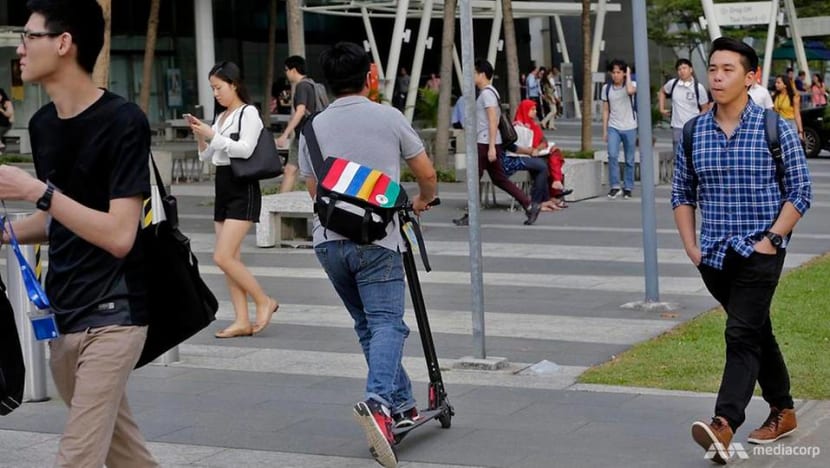Slow ride for PMD insurance: Insurers say interest picking up, but riders point out gaps

An e-bike rider in Singapore. (File photo: TODAY)
SINGAPORE: The take-up rate for insurance has been slow among individual personal mobility devices (PMD) users here, but some insurers that offer such policies said they have seen an uptick in interest recently and are expecting more sign-ups ahead.
This came after new regulations, such as mandatory registration of electric scooters, kicked in, while others are being mulled by the authorities. Accidents involving PMDs, meanwhile, have continued to rise, they said.
Currently, insurance policies targeted at users of PMDs, which include the likes of e-scooters, power-assisted bicycles, hoverboards and electric unicycles, are offered by NTUC Income, Etiqa Insurance, AXA Insurance and the Automobile Association of Singapore (AA Singapore).
Premiums range from S$65 to S$96 for a year’s coverage against injuries, permanent disabilities or accidental death while using a PMD in Singapore. Etiqa Insurance also offers plans that cover one, three and six months at premiums of S$26, S$39 and S$59, respectively.
All four insurers also cover third-party liability when a PMD rider gets into an accident. Such a coverage allows victims to lodge claims for damages, and this ranges from S$200,000 to S$1 million.
This is not typically found in personal accident plans, insurers said, and is an “important” coverage given that the rising popularity of PMDs has also led to an increase in the number of accidents involving these devices.
“Along with safe riding practices, being insured against the potential risks associated with the use of these bicycles and PMDs is taking responsibility not only for self, but also for others should an unfortunate accident occur,” said NTUC Income’s vice president Annie Chua.
Ms Chua, who is also the head of personal lines, said NTUC Income has sold about 200 policies every year since launching the insurance in April 2016.
There has also been a 10 per cent increase in claims year-on-year, though she did not elaborate on the number, type and quantum of these claims.
READ: Ban on personal mobility devices? 'The battle is always against errant use'
READ: Slow start to LTA’s early disposal incentive for e-scooters that don't meet fire safety standards
Etiqa Insurance, which became the second insurer to launch such a product in 2016, declined to reveal the number of policies sold so far but said that between January and October, its take-up rate rose 55 per cent compared to the same period a year ago. Organic search interest in its PMD insurance also saw a 60 per cent jump over the 10 months.
This is due to the mandatory registration for PMDs which kicked in on Jan 2, said its head of business Jazzreal Wong.
"With the recent regulations and accidents, we are expecting (the take-up rate) to increase in the coming few months,” she added.
AXA Insurance noted that about 100 people took up its insurance within the first 3 months since launching it in March.
Similarly, it has observed increasing awareness and interest “in part due to the Government’s regulations around the registration of PMDs”, said its managing director Ankush Bhardwaj.
There are about 90,000 registered e-scooters in Singapore.
In reply to similar queries from CNA, AA Singapore would only say that “take-up rate has been slow but increasing”.
Its policy for individual PMD users has been available since last May, while that for commercial riders was launched a month ago. Both cover PMDs that are registered and compliant with the Land Transport Authority’s (LTA) rules.
“As there is currently no mandatory framework for PMD riders to purchase insurance, riders may feel it is unnecessary to purchase the insurance and do not see the importance of having it,” its spokesperson added in an emailed response.
READ: Major PMD retailers say will not sell devices to people under 16, among other measures
PMD COMMUNITY POINTS OUT GAPS
Last month, the Active Mobility Advisory Panel (AMAP) made several recommendations, which included mandating that businesses procure third-party liability insurance. This allows victims to file claims for damages if they are involved with e-scooter riders who use the vehicles for work.
But the panel, which looks into rules governing the use of PMDs, bicycles and others, stopped short at calling for insurance to be made compulsory for all PMD users.
Cost was an issue for many riders as they find existing premiums to be “significant compared to the cost of an e-scooter”, especially when the insurance has to be renewed annually.
Current insurance plans also contain certain exclusions where compensation would not be paid out if the rider is using the PMD for work or have contravened a rule. “This would undermine the intention to ensure access to compensation for victims of accidents,” the AMAP report wrote.
It added that it recommends the Government “lay the foundation for widespread insurance adoption and continue working with the insurance industry to develop and promote the uptake of affordable and comprehensive third-party liability insurance products for individuals”.
“In the year ahead, the panel will actively monitor the situation and prepare the industry and community to move towards mandatory insurance for all e-scooter users,” said AMAP.
READ: Panel recommends e-scooter users be at least 16 years old, pass theory test before riding on public path
READ: 'Code of conduct' for pedestrians not meant to be prescriptive, says active mobility advisory panel
PMD retailers that CNA spoke to echoed the panel’s take on gaps in existing insurance plans.
Mobot general manager Chew Boon Hur said many riders feel that insurance is “too expensive”.
“If you need to pay about S$80-plus per year (and) if you're talking about an S$800 scooter, it's going to be 10 per cent of the price you paid for a scooter. Two (to) three years down the road, this becomes a significant cost to the rider,” he said.
Owner of PMD retailer Mighty Velo, Vivian Yuan, had questions about the exclusion clauses in some insurance policies. For instance, those that deny third-party liability protection if a rider has broken the law.
Citing the lowered speed limit of 10kmh on footpaths, she said: “It is very hard to maintain that on a bike or scooter. If there is an accident and the speed was found to be 12kmh, does it mean then the insurance will be void?”
Ms Yuan also raised the need for existing insurance policies to specify “acceptable rules on what can be modified and what cannot be modified” on PMDs.
READ: 10kmh riding speed limit on footpaths among new rules to kick in on Feb 1
More than 75,000 e-scooters registered ahead of June deadline: LTA
Noting that the rules on PMDs in Singapore remain “very fluid”, insurers seem to be playing catch-up still, she added.
"Then that makes no sense to buy insurance because why buy them when we are not sure if we can use them?” she told CNA.
Many PMD riders also do not see the value in having a third-party liability insurance as insurance is still viewed as “a kind of ‘touch wood’ thing”, Mr Chew said.
“If it happens, it covers. But most people don't feel it will happen so they don't feel there is a value.”
The General Insurance Association of Singapore (GIA), which has had discussions with AMAP, said insurance premiums are commercial decisions taken on by individual insurers.
“The average premium is affordable compared to the benefit (as) insurance pays the cost of medical expenses, future medical expenses, caregiver expenses, loss of earnings and other losses incurred by victims in the event of an accident,” its chief executive Ho Kai Weng told CNA.
With rules regarding PMDs in Singapore still evolving, Etiqa Insurance noted that it is reviewing its policy to “safeguard the general public and to cater to the needs of PMD users”.
Others said they will continue to monitor and their policies are already regularly reviewed where necessary.

THE CASE FOR MANDATORY INSURANCE
Alongside the increase in the number of accidents involving PMDs, so have calls to mandate a similar insurance framework as vehicles on public roads.
Between 2017 and 2018, there were 228 reported accidents involving PMDs on public paths, of which 196 resulted in injuries.
There have been about eight deaths reported in the media resulting from PMD-related accidents since 2016, with the most recent being the death of 65-year-old Madam Ong Bee Eng.
In Parliament earlier this month, Senior Minister of State for Transport Janil Puthucheary said that a ban on PMDs is possible if rider behaviour did not improve.
At the sitting, Nee Soon GRC Member of Parliament (MP) Lee Bee Wah had said that she hopes the Ministry of Transport would consider allowing only those who passed tests and bought third-party insurance to ride PMDs.
This is so that victims can see proper recourse, she told CNA.
READ: PMD ban not needed right now, but being considered: Janil Puthucheary
READ: MPs suggest banning PMDs on footpaths, having compulsory licensing and insurance for riders
Putting aside the improvements that need to be made to existing policies, PMD retailers like Mr Chew and Ms Yuan also noted the general benefits of having insurance.
“What we try to communicate is that getting insurance is just a rider doing your part,” said Mr Chew. “If one day you really accidentally knock into someone (and) the hospital bills are high, at least you know the insurance company will come in and pay.”
Moving forward, the GIA said it will have another meeting with the AMAP Secretariat “shortly”.
“GIA and its members are focused on and look forward to working closely with the AMAP to cultivate a safer path-sharing culture for all road users,” said Mr Ho.
As for insurers, some like the AA Singapore are doing their part to promote a safe riding culture.
Its two subsidiaries have joined hands to offer policyholders complimentary safety courses, which will help riders identify their risk perceptions and improve behaviours.
“Through the course, they will also be educated on the consequences of unsafe riding habits, and be able to identify hazards on roads to prevent getting into an accident. With this, the aim is to impart and instil a safe riding culture for all road users,” said the AA Singapore spokesperson.
Additional reporting by Zhaki Abdullah.














